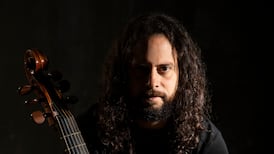Basil Blackshaw is an exceptional figure in contemporary Irish art: a fine painter and a real countryman who actually lives in the country and whose painterly concerns are, by and large, rural. Rural, that is, in a practical, workaday and not at all romanticised way. He is simply at home in the country and has never settled in town. But, as he remarked to Mike Catto of his early years, dispensing with any notions of gentrified country life: "Living in the country was bloody hard work."
His father was a horse trainer, and he too has trained horses, and sheepdogs. Like Barrie Cooke, whose work he is on record as admiring, he comes at nature from the inside out. Horses and dogs, with other farm animals, form a major strand of subject matter, together with landscapes, country scenes, portraits and nudes. His nudes combine a sense of fleeting physicality with unabashed sensuality, a quality characteristic of his style overall. That style is urgent, informal and marked by a kind of rigour, with trying and trying again to get a particular quality of vivid liveliness.
When he tightens up, as he has done in some of his more formal portraits, the results can tend towards a sketchy academicism - though he also has fine portraits to his credit, like his study of the poet Michael Longley. It's true as well that many of his animal studies must count as portraits, they are so specific and characterful. One of his most admirable traits is that, as an artist, he is totally without affectation.
The main exhibition in this year's Boyle Arts Festival picks up on the notion of his exemplifying a rural strand in Irish art. On the face of it, Blackshaw and Friends sounds like a really good idea: an exhibition based on the painter's personal preferences. In practice, it isn't quite like that. It seems that he didn't curate the show in the strict sense of the term. It was more a case of the arts festival inviting him and a wide circle of known friends to exhibit. And the result, with something like 50 artists, is a heterogeneous, good natured, overcrowded affair.
A central consistency does emerge and it involves, predictably enough, a feeling for nature and form. Most obviously, you can see Blackshaw empathising with Cooke's bold drawings of river rocks, or with T.P. Flanagan's expert evocations of water, vegetation and light.
You can also see him warm to Eithne Jordan's mellow summer landscapes and Mary Lohan's shoreline seascapes, all situated in shifting, intermediate tidal spaces. He'd be equally at home with Sean McSweeney's authoritative studies of bogland, Neil Shawcross's iridescent still-life study with its brilliant, fluid reds and yellows, and Nancy Wynne Jones's quicksilver grasp of the atmosphere of place. McSweeney has the rare ability of regularly pulling a really extraordinary painting out of the hat, just when you think there cannot be any more surprises in his habitual terrain. Here, it's The Pool, a real gem.
Equally, Sheila McClean's sensitively observed landscapes, if not as familiar as any of the above, are very good, and Catherine McWilliams has a very convincing, in-your-face view of Ben Bulben. Blackshaw's daughter, Anya Waterworth's Reef, with its transparent washes of oil colour, is almost Cooke-ish. They may be quite different in feeling, but there is a recognisable sympathy between Ross Wilson's vision and Blackshaw's. The same might go for David Crone who, like Wilson, builds up his paintings in dense, incremental layers. Wilson's perfectly camouflaged Graffiti Frog is a wonderful, enigmatic little piece.
Sophie Aghajanian's fleeting, off-balance compositions have something in common with Blackshaw's liking for capturing form on the hoof, as with Dermot Delargy's allegorical rhinoceros prints, Brian Maguire's open, unaffected portrait and Denise Ferran's relaxed cityscapes. Robert Bottom's and to a lesser extent, Colin Davidson's gestural landscapes recall Brian Ballard (who should logically be there, presumably).
There is less overt temperamental correspondence between Blackshaw and other included artists, but he could well respond to specific strengths in their work. These might include Stephen McKenna, whose Regent Street Mist is a beautiful picture, Jean Duncan, at her best in Secret Garden, Chung Eun-Mo, Mark Pepper, Jack Pakenham, Graham Gingles, Bill Freeland, Catherine McCormack Green, Conor Fallon, Melanie le Brocquy and Raphaele McCormack, whose mixed media pieces are very striking.
And Maria Simmonds-Gooding's pared-down, almost sculptural approach to the theme of human habitation in the landscape would probably strike a chord with Blackshaw.
Every year the Boyle Civic Collection acquires works from the festival exhibition. Since its inception in 1990, the Civic Collection has grown to become a creditable collection of contemporary Irish art. Some of this work is on view at King House in Boyle, though available exhibition space there is limited. Fergus Ahern's hope that "some day the collection will be granted greater space in King House" is logical and desirable from everyone's point of view.
This comes after the Haverty Trust, which buys works by Irish artists and places them in deserving collections, presented three works (by Michael Warren, Eithne Carr and Gene Lambert) to the collection in acknowledgement of its growing stature, and after the collection won the provincial award in the AIB Better Ireland Awards. They are obviously doing something right.










